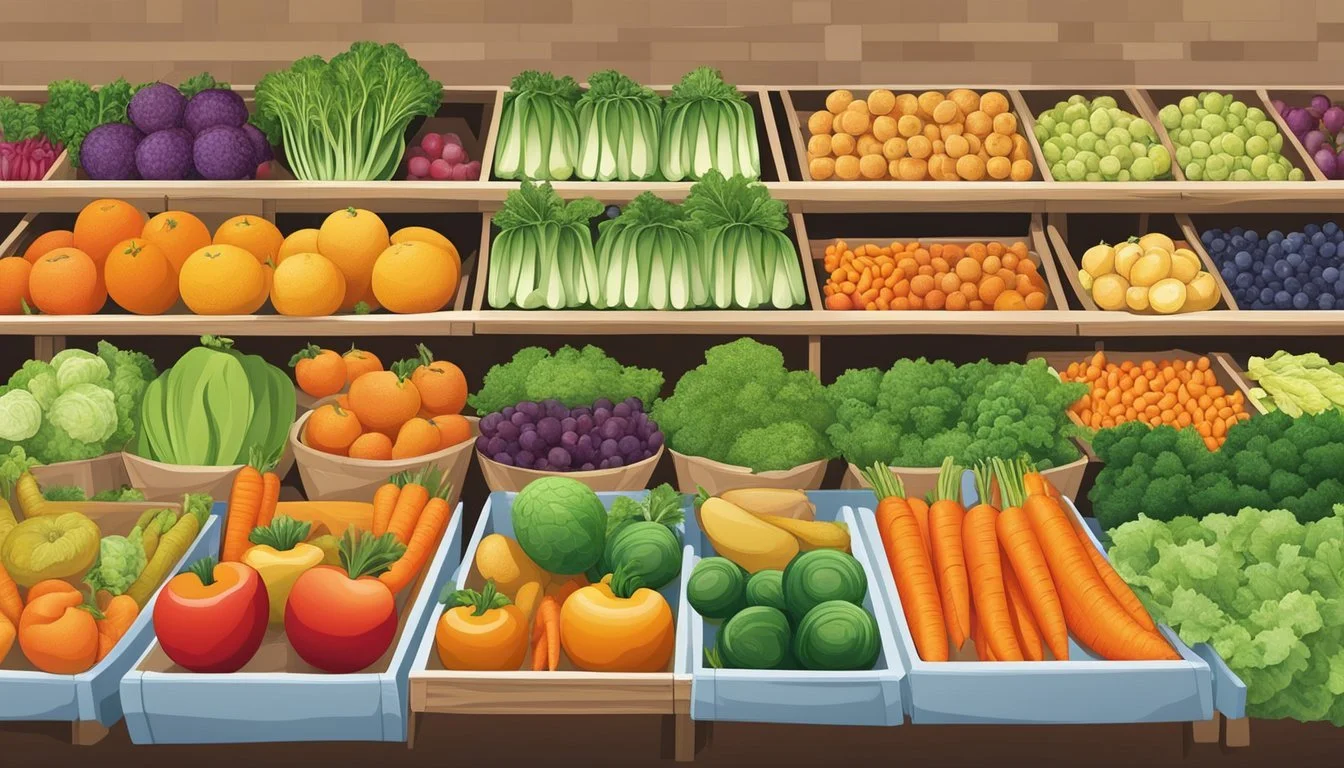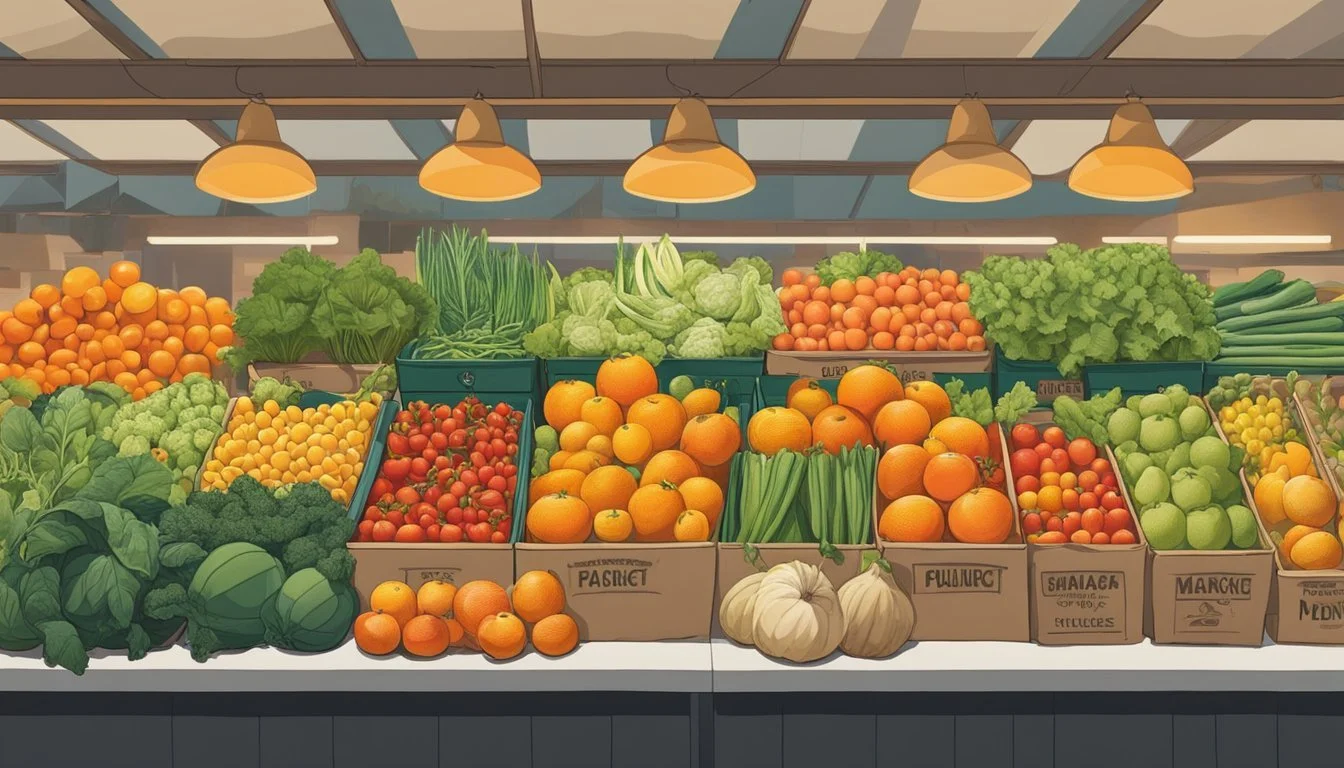New Mexico Seasonal Fruit & Vegetables in March
Your Guide to Fresh Picks
This Article is Part of our New Mexico Seasonal Fruit & Veg Calendar
In March, the landscape of New Mexico begins to hint at the forthcoming spring with a modest yet promising variety of seasonal produce. The state's varied climate, ranging from arid deserts to high mountains, affects the availability of fruits and vegetables, making each region’s harvest times slightly different. Despite these regional variations, certain crops emerge consistently across the state during this time.
Root vegetables continue to thrive in New Mexico's cool March soil, with offerings that typically include beets, carrots (how long do carrots last?), and potatoes. Leafy greens like spinach (What wine goes well with spinach?) and kale are also in season, providing fresh and nutritious options for salads and cooking. As the state transitions from winter to spring, these vegetables are prized for their freshness and flavor, as they are often harvested at peak ripeness.
While fruit selections in March are limited compared to the bountiful summer months, New Mexicans can enjoy the last of late-winter citrus fruits. Fruit trees, such as apple and pear, remain dormant, but preparations for the upcoming growing season begin as the weather warms. Savvy consumers often turn to preserved or stored produce from previous seasons, such as dried chile, to complement the fresh seasonal offerings.
Overview of Seasonal Produce in New Mexico
New Mexico's seasonal produce offers a variety of fresh fruits and vegetables. These selections are influenced by the state's unique March climate conditions, which affect crop maturity and availability.
Benefits of Eating Seasonal Produce
Eating produce that is in season in New Mexico not only supports the local economy but typically offers higher nutritional content and better flavors. Seasonal fruits and vegetables are harvested at their peak of freshness, ensuring a superior taste and texture. For example, seasonal fruits like cherries and vegetables such as spinach are often more flavorful and juicier when consumed within their natural growing period. Moreover, choosing local, seasonal produce may reduce food miles, contributing to environmental sustainability.
March Climate Influence on Crops
The March climate in New Mexico has a tangible impact on the types of crops that thrive. Cooler temperatures in early spring influence the state’s agricultural output, with mild days and cool nights being ideal for certain crops. During this month, consumers can expect to find a selection of root vegetables and leafy greens, as these crops are well-suited to the cooler weather. The range of produce includes, but is not limited to:
Root Vegetables: carrots, beets, potatoes
Leafy Greens: various types of lettuce, spinach, kale
Farmers across the state diligently tend to their crops, utilizing the season's conditions to grow fresh and raw fruits and vegetables. Organic options are often available, catering to those preferring produce cultivated without synthetic pesticides and fertilizers. As the growing season begins, they provide a foretaste of the abundance that will continue to ripen as temperatures warm.
Fruits Available in March
In March, New Mexico showcases a limited but fresh variety of fruits due to its seasonal climate. The selection mainly includes citrus and some early berries, with tropical and stone fruits being less common at this time of year.
Citrus Varieties
March sees a continuation of the citrus season in New Mexico with lemons and oranges still available. These citrus fruits may not be at their peak but are typically still accessible.
Lemons: Offer a tangy flavor and are versatile for both culinary and household uses.
Oranges: Known for their sweetness and rich vitamin C content.
Berry Types
As spring approaches, berry varieties start appearing in the market.
Strawberries: Begin to come into season, offering sweet and juicy flavors.
Raspberries: Might be found, but their availability depends heavily on local growing conditions.
It’s worth noting that the availability of blackberries is not prominent in March.
Tropical and Stone Fruits
Most tropical and stone fruits are not in season in March in New Mexico. However, with controlled environment agriculture, one may find limited quantities of these fruits.
Plums and nectarines: Typically are not available during this time.
Figs: Occasionally, one might find the early varieties of figs in specialized markets or stores.
It is important for consumers to check with local farmers' markets or produce suppliers for the most up-to-date information on fruit availability.
Vegetables and Greens in Season
In March, New Mexico's vegetable selection showcases a vibrant variety of vegetables that are in their prime. This is the season for revitalizing greens, sturdy root vegetables, nutrient-dense cruciferous veggies, and the earthy flavors of nightshade and gourd vegetables.
Leafy Greens
Spinach and arugula (how long does arugula last?) are lush and abundant, offering a fresh, peppery kick to salads and dishes.
These greens are packed with nutrients and adapt well to both raw and cooked applications.
Root Vegetables
Hearty root vegetables like carrots, radishes, and onions reach optimum sweetness and texture.
Garlic and leeks also provide robust flavors, essential for aromatic bases in many dishes.
Winter favorites like parsnips and sweet potatoes are still available, with their earthy notes ideal for roasting.
Cruciferous Vegetables
Cabbage is crisp and sweet, perfect for slaws or fermenting into sauerkraut (how long does sauerkraut last?).
Broccoli and cauliflower are also in season, excellent for hearty soups or as nutrient-rich sides.
Nightshade and Gourd Vegetables
New Mexico's famous green chile and red chile can be found, enriching dishes with their distinctive warm and spicy flavors.
While tomatoes, peppers, and gourds like pumpkin are less common this time of year, greenhouses can provide these typically summer crops.
Herbs and Aromatic Produce
In March, New Mexico welcomes the growth of an array of aromatic herbs, each offering unique flavors to enhance the culinary experience. Gardeners and chefs await the first harvest of these herbs to incorporate them into diverse dishes.
Cilantro (how long does cilantro last?) is prevalent during this time, with its bright and piercing freshness. It's a versatile herb commonly used in salsas, salads, and as a garnish for a variety of dishes.
Basil (how long does basil last?), known for its sweet and peppery flavor, starts to make its appearance. Basil adds a distinct touch to pesto, soups, and as a flavorful companion to fresh tomatoes.
Oregano is another staple in New Mexican March herb gardens. Its robust and slightly bitter taste is a signature in Italian, Mexican, and Mediterranean cuisine. It pairs well with meats, tomato sauces, and grilled vegetables.
Thyme is appreciated for its subtle, earthy flavor with a hint of mint, emerging to complement stews, roasted meats (What wine goes well with roasted meats?), and vegetable preparations.
A visual representation of these herbs and their common uses:
Herb Flavor Profile Common Uses Cilantro Fresh and citrusy Salsas, salads, garnishes Basil Sweet and slightly peppery Pestos, soups, tomato dishes Oregano Robust and slightly bitter Italian and Mexican dishes Thyme Subtle and earthy with a hint of mint Stews, roasted meats, vegetables
These herbs not only add depth to food but also bring the promise of spring with their fragrant presence in New Mexico’s seasonal palette. Chefs and home cooks alike appreciate these herbs for their ability to transform a dish with their distinct flavors.
Using New Mexico Seasonal Produce
March in New Mexico brings a variety of seasonal fruits and vegetables that offer vibrant flavors and nutrition. This section provides practical advice on how to incorporate these seasonal ingredients into daily cooking and effective ways to preserve their freshness.
Recipes and Cooking Tips
When incorporating March seasonal produce from New Mexico into recipes, one can be both creative and healthy. Root vegetables such as carrots and sweet potatoes are abundant and can be roasted to bring out their natural sweetness or added to salads for a nutritious crunch. They are also excellent in soups and stews, contributing rich flavors and textures.
Salad Greens, like spinach, can be used fresh in salads or wilted into pasta (how long does pasta last?) dishes, enhancing both the taste and nutritional profile.
Herbs, available fresh during this time, can greatly elevate the flavor of dishes—add cilantro to a salsa or parsley to a fresh salad.
Utilizing mushrooms in recipes provides a meaty texture that's perfect for vegetarian dishes (What wine goes well with vegetarian dishes?). They can be sautéed with garlic and herbs and added to a pasta for a hearty meal.
Preservation and Storage
To maximize the shelf life of March’s seasonal produce, proper preservation and storage techniques are necessary:
Root Vegetables: Store in a cool, dark place with good ventilation; they can be kept for several weeks.
Greens: Keep unwashed and refrigerated in a sealed plastic bag to maintain freshness; use within a few days.
Herbs: Either dry or freeze herbs, or keep them in a jar of water in the fridge.
Fresh veggies often taste best when consumed raw or minimally processed to preserve their nutrients and flavors. When cooking, gentle methods such as steaming or grilling can maintain the integrity of the produce.
Local Agriculture and Farming Practices
New Mexico's agricultural sector is integral to its local economy, providing a diverse array of seasonal produce through sustainable methods and direct-to-consumer sales models like farmers markets and CSAs.
Organic and Sustainable Farming
Organic farming practices take a prominent role in New Mexico, emphasizing the health of the soil, ecosystems, and people. These practices avoid the use of synthetic fertilizers and pesticides, instead relying on natural methods such as crop rotation and composting to maintain soil fertility and control pests. Sustainable farming in New Mexico also includes water conservation techniques, crucial in the state's arid climate.
Farmers Markets and Community Supported Agriculture (CSA)
Farmers markets are a staple in New Mexico, allowing consumers to purchase fresh, local, and often organic seasonal produce directly from farmers. These weekly events support the state's small farms by providing them with a venue to sell their goods. Furthermore, Community Supported Agriculture programs (CSA) have gained traction, with consumers subscribing to receive a regular share of produce, thus investing in local agriculture and connecting more closely with where their food comes from.
Health and Nutrition
When considering the health benefits and nutritional value of fresh produce, March in New Mexico offers a cornucopia that can enrich a balanced diet. The seasonal offerings are not only flavorsome but also packed with essential nutrients.
Vegetables like spinach and kale are prominent at this time of year; they are low in calories yet high in vitamins A, C, and K, as well as minerals like iron and calcium. These leafy greens contribute to strong bones, immune system support, and improved eye health.
The fruit selection, although more limited in March, is no less nutritious. Strawberries begin to make an appearance, and they are a particularly good source of vitamin C and manganese. This nutrient-dense fruit also contains antioxidants known as polyphenols and is associated with heart health.
Seasonal Produce Key Nutrients Spinach Vitamins A, C, K, Iron, Calcium Kale Vitamins A, C, K, Calcium, Iron Strawberries Vitamin C, Manganese, Polyphenols
Many consumers opt for organic produce to avoid pesticides and to support sustainable farming practices. These organic options often present fresher alternatives that can be richer in certain nutrients.
Consuming a variety of these fruits and vegetables helps individuals maintain a healthy diet. As fresh produce contains significant amounts of water and dietary fiber, it can aid in digestion and hydration.
In sum, New Mexico's March produce contributes essential nutrients to a diet without compromising on taste—each selection brings its own set of health benefits to the table.
Shopping Guide for Seasonal Produce
March in New Mexico offers a variety of fresh and ripe seasonal produce. Shoppers can enjoy a wealth of fruits and vegetables at their peak of flavor.
Selecting Quality Fruits and Vegetables
When purchasing fruits and vegetables, look for those that are firm, vibrant in color, and free from any blemishes or signs of spoilage. For certain produce like avocados or kiwifruits, a slight give under pressure indicates ripeness. Always check for a pleasant aroma, especially in fruits, as this is a good indicator of freshness and taste.
Seasonal Produce Calendar
Fruits in Season:
Citrus fruits such as oranges and grapefruits
Apples, if stored from the fall
Vegetables in Season:
Greens like spinach and lettuces
Root vegetables like beets and carrots
Cruciferous vegetables such as broccoli and cauliflower
Shoppers should be aware that New Mexico's weather can affect the exact timing of produce availability, and it is always best to consult local farmers' markets for the most current selections.
Cultural Culinary Traditions
March in New Mexico brings a blend of vibrant culinary practices, closely tied to the local seasonal produce. This is the time when traditional dishes are prepared with ingredients at their peak, capturing the essence of the region's food heritage.
New Mexican Cuisine
In New Mexican cuisine, seasonal produce in March such as radishes, turnips, parsnips, and rutabagas enrich the palette of flavors. One finds them skillfully incorporated into iconic dishes that span various culinary techniques and preferences.
Tamales: A beloved staple often filled with seasonal vegetables, providing a fresh twist to the classic corn masa dish.
Enchiladas: Rolled or stacked, these are sometimes adorned with crisp radishes or green chile, which is a year-round favorite though not specific to March.
Local residents might whip up a fresh salsa using early spring greens, creating a perfect accompaniment for both tamales and enchiladas. March's produce also offers a fresh take for vegetarian options or side dishes within the New Mexican cuisine.
Fusion Dishes Influenced by March Produce
Chefs and home cooks alike take inspiration from March's bounty to create fusion dishes that marry traditional New Mexican flavors with other cuisines:
Omelets: Elevated with a New Mexican twist by featuring roasted turnips or a dash of green chile, reflecting the region's flair within a classic breakfast staple.
Tacos: Transcended from the simple to the sublime with fillings like sautéed parsnips or radishes, offering a seasonal and textural contrast to the softness of the tortilla.
These fusion dishes showcase a harmonious blend where the versatility of March's produce is celebrated, maintaining the authenticity of New Mexican flavors while introducing them to broader culinary contexts.
Conclusion
March in New Mexico brings with it an array of fresh, nutritious produce selections that embody the emerging spring season. Root vegetables and leafy greens are particularly abundant during this period. Consumers have the opportunity to enjoy a variety of vegetables such as arugula, beets, carrots, and spinach. These items not only offer vibrant flavor but also provide essential vitamins and minerals that contribute to a healthy diet.
In terms of fruits, options might be somewhat limited due to the seasonal transition. Nonetheless, the availability of certain fruits that withstand the cooler temperatures can still be found. Interested buyers can connect with local markets to discover which specific fruits are ripe for consumption.
When purchasing produce, it’s advisable to consider whether to opt for organic or non-organic items. Factors such as pesticide residue vary among different fruits and vegetables, which can influence buyer decisions based on health and environmental concerns.
By choosing seasonal produce, consumers support local agriculture and enjoy flavors at their peak. Moreover, the practice of consuming in-season fruits and vegetables promotes sustainability and can often result in economic savings.
Here’s a quick glance at some of the vegetables available in March:
Vegetables:
Arugula
Beets
Carrots
Garlic
Lettuce
Onions
Potatoes
Radishes
Spinach
New Mexico’s rich agricultural landscape is showcased through its seasonal offerings, ensuring that residents and visitors alike can partake in the fresh bounty provided by local farms.











